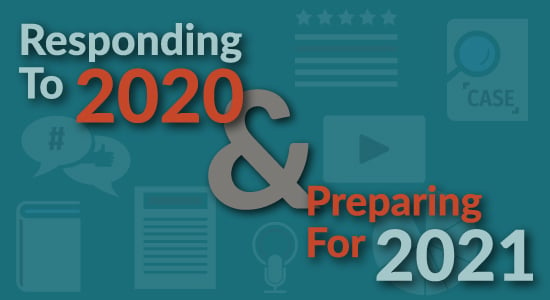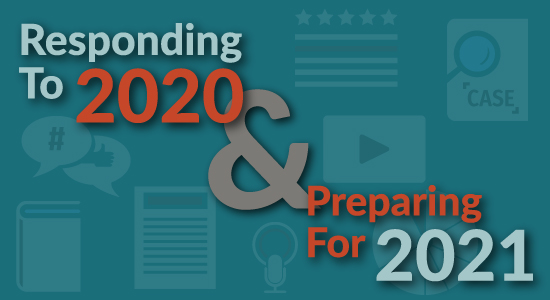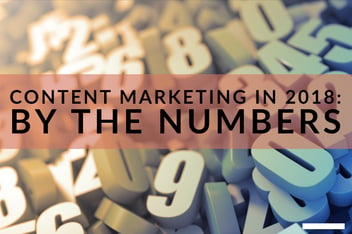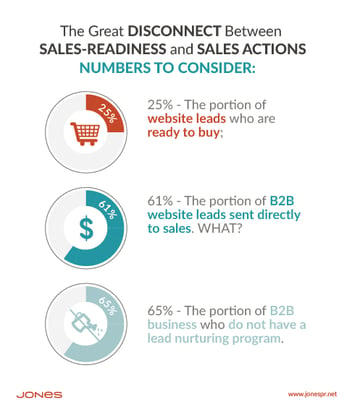B2B Content Marketing: Responding To 2020 & Preparing For 2021

Ever look around and wonder what is happening inside other marketing departments? What fuels their success? Do they do it all themselves? What kinds of content are they really creating?
Each year, the Content Marketing Institute and MarketingProfs work to answer those questions, and this year’s insights provide an extra glimpse at what the first few months of the Covid-19 pandemic meant for content marketers. Let’s unpack some of the survey results and how they can be applied to your content and integrated marketing strategies.
(Find the full report here: 11th Annual B2B Content Marketing Benchmarks, Budgets, and Trends Report.)
Characteristics of the most successful marketers:
The surveys asks B2B content marketers to rate the successfulness of their program, as well as asking a number of questions about tactics their marketing program uses or processes they follow, in order to cross-reference what the most successful content marketers do that others may be missing. Some of those results seldom change from year to year, but here is how they stacked up in mid-2020.
Documented strategies
As usual (we’ve reported these results before), the most successful marketers were much more likely to have a documented content marketing strategy—60 percent of the most successful marketers do, vs. only 21 percent of the least successful marketers. Putting your strategy into writing just makes sense. It means everyone understands the goals, everyone understands the messaging, and everyone understands how the individual components of your content marketing strategy work together and how they work with the rest of your sales and marketing machine to achieve corporate objectives.
Editorial calendars
As we talk about putting it in writing, even more of the most successful content marketers—80 percent—use an editorial calendar. Half of the least successful marketers skip this step, which to me means they spend too much time just casting around trying to decide what to do next because they haven’t taken time in advance to think it all through.
We have developed a couple of tools that make planning an overall strategy, specific campaign elements, and a detailed business blog calendar easier, and I’m glad to share them with you here:
- Plan A Year’s Worth of Marketing Campaigns (how-to post and free template)
- How To Plan Your Business Blog Calendar (how-to post and free template)
We use these tools not only for our own planning, but also to develop comprehensive content marketing campaigns and business blog plans for our clients. Of course, the plan and calendar are just the beginning, and it is important to be flexible, but by outlining your intentions, you and your team have a head-start on accomplishing them.
Metrics analysis
Just as the most successful content marketers take time on the front end to plan out and document their strategy and editorial calendar, they also make time on the back side to measure performance and analyze results. Nearly all (94 percent) of the most successful marketers use metrics to measure content performance, but only 60 percent of those who are struggling follow through with this step.
Analyzing metrics is one of the core elements in our JONES marketing methodology because it provides so much useful information for the future. Not only can it identify which topics, content types or distribution channels perform best at attracting traffic, but it can also point out holes in the sales funnel. And, analytics are key to one of the biggest challenges cited by content marketers: proving the ROI of your efforts.
Check out these resources for more insights into why and how to use metrics to improve your marketing content and prove its effectiveness to the executive suite and others in your organization.
- Unlock the ROI Of Your Marketing With Analytics
- JONES + HubSpot: Analytics Solutions
- 6 Marketing Metrics Your Boss Actually Cares About
Full-funnel focus
While some philosophies seem to think of content strictly as an awareness tool, the survey results unveil that the most effective marketers approach their content from a perspective that starts at the top of the sales funnel, but then continues to use content to nurture leads and to close deals so that it is instrumental in generating leads and sales.
According to the survey, nearly 3 in 4 of the most successful marketers use content successfully to nurture subscribers, an audience or leads; only half as many of the least successful marketers use content to nurture. When asked if they successfully use content to generate sales and revenue, 64 percent of the most successful content marketers said yes, but only 41 percent of the least successful marketers had the same response.
Content marketing is most successful when approached from an integrated, full-funnel perspective—not simply as an awareness-generation tactic. Surveys of B2B buying decision makers show that they consume a large amount of content throughout the buying cycle, which means B2B marketers need to consider how to support sales by providing the content needed at every step of the way.
The Campaign Planning Calendar Template I mentioned above can help guide you in planning content that gains awareness, nurtures leads through a long buyers’ journey and provides the key information at the right time to close a deal. You can also use tools such as those in our Lead Nurturing Toolkit to develop the rest of the workflow and emails that put that content where leads want it when they want it.
B2B content marketing successes and challenges
The B2B Content Marketing Benchmark survey also asks marketers what they believe contributes to their success and what provides the greatest challenges. There are definitely connections between the answers to each question, especially the topic that lands at the top of each list.
What do successful marketers attribute their success to?
More than 8 in 10 of most successful content marketers say that their success traces back to this: the value provided by their content. This is no surprise to me. One of our commitments at JONES is to provide great content, not just pump out quantity at the expense of quality. There is too much content out in the market already to succeed by just generating more noise.
Great content provides value to readers, and in turn, benefits marketing efforts. It should:
- Have character or tell a story.
- Be useful – consider creating checklists, templates or providing information that can’t be found anywhere else.
- Be findable—optimize for search and share in multiple channels.
- Be shareable—make it something your readers want to share, then make it easy to share from your social media or blog.
- Be grammatically correct and technically sound—jettison the buzzwords, double-check and triple-check spellings, and use reader-friendly formatting to make the message clear.
We have found that the secret to consistently producing content that provides value to readers (and therefor succeeds in meeting marketing goals) is to hire only excellent, experienced writers and to give them the time and resources to do what they do best. Feeding the content development process with original data doesn’t hurt either.
More on those approaches here:
- Why Creating Great Content Matters
- Lessons From 15 Years: Use Surveys & Original Research To Fuel Content
The second most-cited key to success in the survey was website changes, including the addition of new content, to which 60 percent of the most successful content marketers attributed their success. Again, this is not surprising. Content is essential to website success, in terms of both SEO and UX. Without high-quality, useful content, your website is unlikely to rank high on search engine results pages or to convert visitors into leads.
Other aspects of the website, including infrastructure and interface, also impact its success as a marketing tool. Try using our Website Audit Template to take a closer look at your own website to find opportunities to improve its effectiveness.
What challenges haunt the least successful marketers?
While content gets top credit for success amongst the best content marketers, content creation is also the most vexing problem for those struggling. More than 60 percent of the least successful content marketers cite content creation as the greatest challenge.
Again, the resources linked above can be useful in addressing this issue.
Half of the least successful marketers cite strategy issues as a top challenge that is impeding their programs. In that case, it may be time to bring in a fresh, objective partner who can bring a new focus to the overall marketing and content strategy and help document a new approach.
Content marketing details
While the previous questions offer big picture views of how B2B content marketers approach their jobs, the survey also digs into the nitty-gritty details of what kinds of content are being created, how they are distributed, and what metrics are used to measure success.
Content types used
Here’s another “no surprise” statistic from the 2020 survey, conducted mid-summer about 3 months into the coronavirus pandemic in the United States:
In-person marketing events plummeted, while the use of virtual events, webinars and online courses increased from being used by 57 percent of B2B content marketers in the 2019 survey to 67 percent this year. That isn’t a huge jump, but I would anticipate that those tactics will continue to increase in use as the virus and its social and economic impact are still growing in many parts of the country.
The proportion of marketers using livestreaming also increased, from 1 in 10 in 2019 to nearly 3 times that many this year.
Beyond those changes, here are the types of content most often used by B2B content marketers in 2020 (with links to resources and discussions of how to use them effectively):
- Blog posts/ short articles (93%)— Why You Should Start A Business Blog Now: SEO & Lead Generation
- Email newsletters (77%)—Email For Inbound: Do This, Not That ebook
- Case studies (68%)—Give Potential Sales Leads High-Value Content Offers
- Videos (preproduced) (68%)—Using Video For B2B Marketing
- Infographics/charts (65%)—7 Characteristics Of The Best Infographics
- Ebooks/guides (54%)—5 Downloadable Assets To Kick Off Your Next Inbound Marketing Campaign
- White papers (47%)—Real Life Examples of Downloadable Offers For Inbound Marketing
- Long-form text (3,000+ words) (32%)—Pick The Perfect Length For Your Next Blog Post
- Research reports (28%)—Use Surveys & Original Research To Fuel Content
Content distribution:
Content distribution is just as important as the content itself—it needs to reach the intended audience.
The most common content distribution channels should come as no surprise: more than 85 percent of B2B content marketers use each of the following: social media, email and the company website or blog. Each of these is an important cog in the machine, and they should each support one another:
- Promote blog posts on your social media platforms and through emails.
- Encourage blog readers to sign up for an email newsletter.
- Provide links to social media accounts on your blog and in emails.
- Encourage blog readers to share your posts on their own social media newsfeeds.
- Repurpose infographics as both a blog post and as a social media visual element. Do the same with videos.
What is missing from many content marketers’ arsenals, however, is the contribution of guest posts or articles to third-party publications. Perhaps this type of thought leadership is being done by others in the organization, such as a PR department, but contributed articles can be a strong part of an integrated marketing and PR strategy that raises awareness and builds authority in the industry.
Learn more about how we use bylined articles for our clients:
- Client Success: How Bylined Article Placement Drives Web Traffic
- How To Get Your CEO Published ebook
By placing contributed articles with trusted third-party publications, you can also maximize the mileage from a single content concept: write it as a blog post, as a contributed article, and as a downloadable report, with adjustments in presentation for the audience and channel.
When it comes to using social media for organic B2B content marketing and content distribution, LinkedIn rises to the top, with 96 percent of those surveyed using the business-oriented platform. Twitter and Facebook were tied, cited by 82 percent of the marketers surveyed, with YouTube used by 62% and Instagram by 49%.
For best practices on using each of these platforms for B2B content marketing, read our Complete Social Media Guide: What, Where, When, and How Often To Post.
Metrics:
Most of the more than 1,700 B2B content marketers who responded to the survey (more than 80 percent) do measure some aspect of their content marketing, but those measurements tend to be initial engagement/traffic based vs. revenue based.
Let’s talk about what I mean. As marketers, we can and should use a lot of detailed metrics that reflect the effectiveness of our program in achieving marketing-oriented goals such as increased website traffic, improved email engagement and keeping visitors on our website longer. And most marketers who measure do track those things:
- 90 percent measure website traffic
- 86 percent measure email engagement
- 84 percent measure website engagement
Similar types of awareness-level metrics you likely track include blog readership, email newsletter subscriber numbers, and traffic sources (direct, social media, search, etc.). These are all important to the content marketing team because they help identify which tactics, topics and channels are getting the attention of the audience.
The survey also notes that 80 percent of those who track metrics measure the rate of conversions—web visitor to lead or lead to customer. Now we’re getting into the meatier part of the metrics, and the ones that matter more to others outside the marketing department.
But that seems to be where it stops for most content marketers. Only about half track metrics about qualified leads, and only 37 percent measure the cost to acquire a lead, subscriber or customer. And those are the questions the executive suite is likely to ask at budget time. In fact, customer acquisition cost is one of the metrics specifically spelled out in our ebook 6 Marketing Metrics Your Boss Actually Cares About.
How marketers changed their approach in response to pandemic:
With the timing of the survey falling just a few months after global reactions set in, The Content Marketing Institute and its partners sought to learn about how the content marketing field was impacted by what was happening in the world around them.
The most common change noted was a shift in the targeting or messaging strategy (70 percent), followed by adjustments to the editorial calendar (64 percent). That just makes sense, as businesses were pivoting to address new realities of bottlenecked production and transportation, a shift to sending many workers to work from home, and uncertainty about the extent and duration of the upheaval.
I want to point out that having a documented strategy and written editorial calendar, as we talked about at the beginning of this post, actually makes it easier to make these kinds of changes without losing sight of the end goal. That written strategy still provides guidance, and the calendar can be adjusted without having to go back to the drawing board and start from scratch.
Other changes that were made by a significant portion of B2B content marketers:
- Changed content distribution/promotion strategy – 53%
- Changed website – 40%
- Put more resources toward social media/online communities – 40%
Some, though not many:
- Re-examined customer journey
- Increased time talking with customers
- Changed products/services
- Revisited personas
- Adjusted KPIs
- Changed metrics
Changes to budgets and resourcing marketing efforts deserves its own discussion—watch for a blog post with those responses to follow soon. (Spoiler alert: There wasn’t a mass reduction in content marketing budgets.)
Even with changes being made and challenges to overcome, and still more to consider as the global pandemic continues, content marketing is here to stay. But as we have said, and as Robert Rose, chief strategy advisor at Content Marketing Institute, notes in his “Forward Projections” from the report, content marketers need to be able to think beyond just content creation.
“As content marketers, it’s not enough to just understand how to create blogs, infographics, or other media assets. We need to understand how content operations work at scale. That means understanding technology, governance, and how to structure content so that it can be reused, repackaged, and leveraged across silos.” (Emphasis is mine—this is our guiding principle in how we approach every project as an integrated marketing and PR firm.)
As I said, we’ll cover the budget and resources parts of the 11th Annual B2B Content Marketing Benchmarks, Budgets, and Trends Report soon. If you don’t want to miss it, be sure to subscribe to the Inbound Accelerator blog for weekly digests of all of our new posts and infographics about content and inbound marketing.
-1.png?width=1652&height=294&name=Jones(RGB)-1.png)












